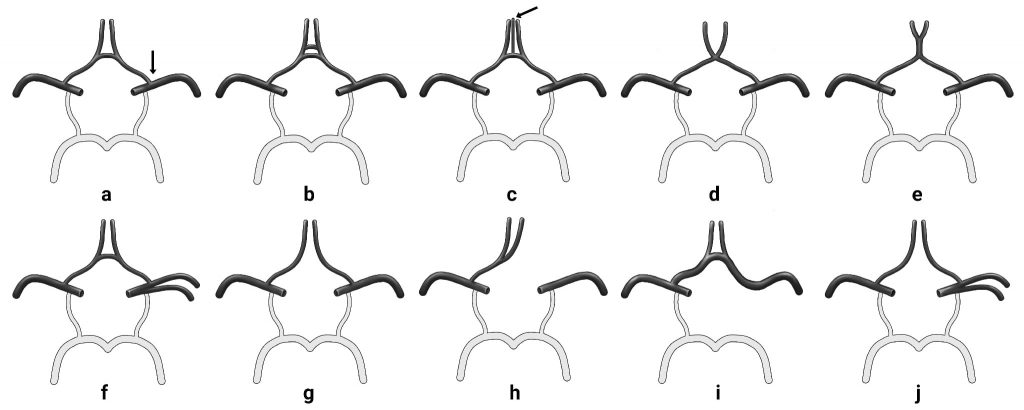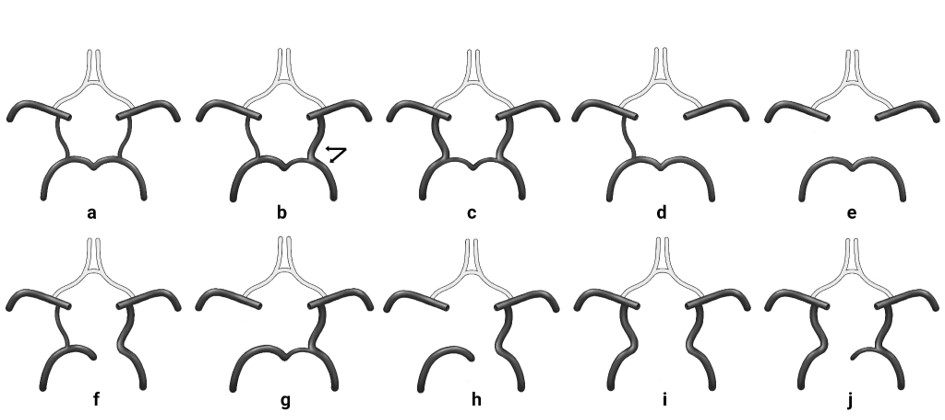Classification of the circle of Willis configuration variants
- No distinction is made between hypoplasia and aplasia
- Hypoplasia is defined as an artery diameter < 1 mm

Anatomical variations in the anterior part of the CoW. Variants A-F are complete, whereas variants G-J are incomplete. A, a single anterior communicating artery. The internal carotid artery (ICA) bifurcates (arrow) into the precommunicating segment of the anterior cerebral artery and the middle cerebral artery (MCA). B, Two (or more) anterior communicating arteries. C, Medial artery (arrow) of the corpus callosum arises from the anterior communicating artery. D, Fusion of the anterior cerebral arteries over a short distance. E, Anterior cerebral arteries form a common trunk and split distally into two postcommunicating segments. F, MCA originates from the ICA as two separate trunks. G, Hypoplasia or absence of an anterior communication. H, One precommunicating segment of an anterior cerebral artery is hypoplastic or absent, the other precommunicating segment gives rise to both postcommunicating segments of the anterior cerebral arteries. I, Hypoplasia or absence of an ICA. The contralateral precommunicating segment of the anterior cerebral artery gives rise to both postcommunicating segments and supplies retrograde flow to the ipsilateral precommunicating segment, which, in turn, gives rise to the ipsilateral MCA (both anterior cerebral arteries and both MCAs are supplied by a single ICA). J, Hypoplasia or absence of an anterior communication. The MCA arises as two separate trunks.

Anatomic variations in the posterior part of the CoW. Variants A-C are complete, whereas variants D-J are incomplete. A, Bilateral posterior communicating arteries present. B, Posterior cerebral artery originates predominantly from the internal carotid artery (ICA). This variant is known as a unilateral fetaltype posterior cerebral artery (arrows); the posterior communicating artery on the other side is patent. C, Bilateral fetaltype posterior cerebral arteries with both precommunicating segments of the posterior cerebral arteries patent. D, Unilateral posterior communicating artery present. E, Hypoplasia or absence of both posterior communicating arteries and isolation of the anterior and posterior parts of the circle at this level. F, Unilateral fetaltype posterior cerebral artery and hypoplasia or absence of the precommunicating segment of the posterior cerebral artery. G, Unilateral fetaltype posterior cerebral artery and hypoplasia or absence of the contralateral posterior communicating artery. H, Unilateral fetaltype posterior cerebral artery and hypoplasia or absence of both a precommunicating segment of the posterior cerebral artery and the posterior communicating artery. I, Bilateral fetaltype posterior cerebral arteries with hypoplasia or absence of both precommunicating segments of the posterior cerebral arteries. J, Bilateral fetaltype posterior cerebral arteries with hypoplasia or absence of one precommunicating segment of a posterior cerebral artery.
